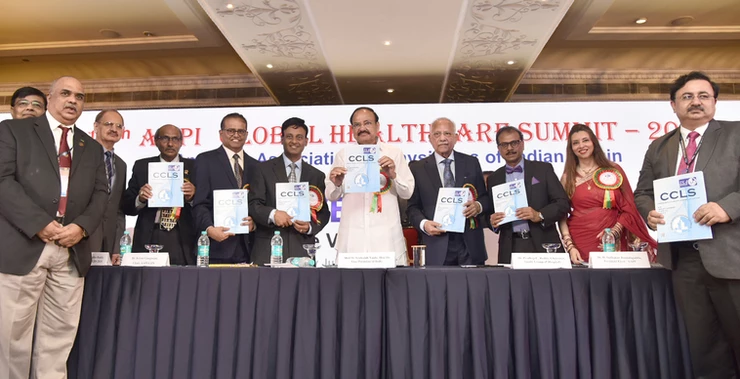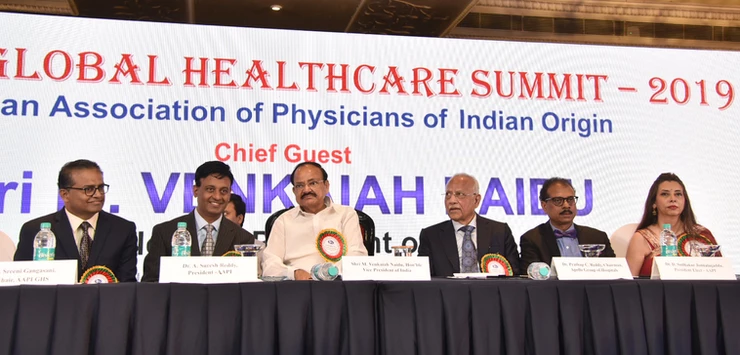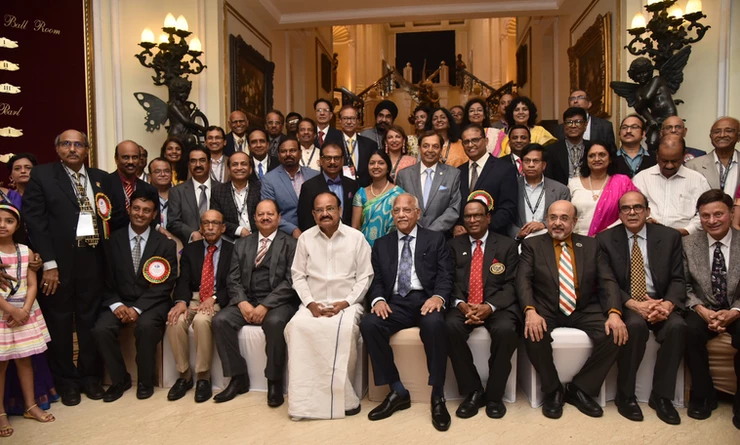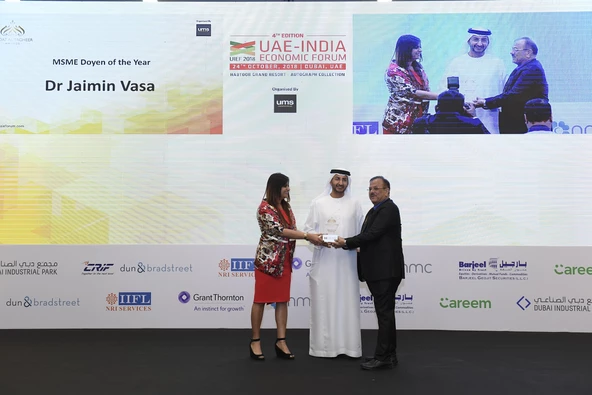July

Vice President of India appeals doctors to adopt concept of ‘Medical Social Responsibility’
The Vice President of India, Shri M. Venkaiah Naidu has urged doctors belonging to the Indian diaspora to give back to the society by adopting their native villages and strengthening Primary Health Centres (PHCs).
Inaugurating the 13th Global Healthcare Summit organized by the American Association of Physicians of Indian Origin (AAPI) and Global Association of Physicians of Indian Origin (GAPIO), in Hyderabad today, Shri Naidu advised the doctors to take active interest in the functioning of PHCs in their villages and help to improve them. Pointing out that nearly 86 per cent of all the medical visits in India are made by people living in rural areas with majority required to travel long distances, the Vice President called for paying greater attention to PHCs, which play a pivotal role in building a robust low cost healthcare system.

Expressing his concern over the rising incidence of non-communicable diseases (NCDs) which accounted for 61.08 per cent of all deaths in the country in 2016, Shri Naidu asked the medical fraternity to adopt the concept of ‘Medical Social Responsibility’ on the lines of CSR and appealed to doctors to visit schools once every week and counsel the children on the dangers posed by lifestyle diseases and unhealthy dietary habits. Calling for a national movement against NCDs, the Vice President urged the Indian Medical Association to take the lead in promoting awareness, particularly among the students, for adopting healthy lifestyles. The Vice President also wanted organizations like AAPI to collaborate with the government in conducting massive screening programs and share their expertise in combating NCDs.
Stressing the need to establish NCD clinics in both urban and rural areas, Shri Naidu urged the private sector to play a prominent role in setting up such clinics. The Vice President opined that inadequate public spend, low doctor-patient ratio, high share of out-of-pocket expenditure, inadequate infrastructure in rural areas were the main problems surrounding healthcare in India.

Expressing his concern over the huge shortage of qualified medical practitioners in India, Shri Naidu called for bridging the gap by opening more medical colleges and increasing the number of seats at both graduate and Post-graduate levels.
Referring to the report of McKinsey Global Institute which has estimated that the implementation of telemedicine technology could save $4-5 billion every year and replace half of in-person outpatient consultations in India, he wanted organizations like AAPI and GAPIO to help remote hospitals in India to acquire latest telemedicine equipment.
The Vice President said there was also a need to organize massive awareness drives to sensitize people on the practices to be adopted for disease prevention. “We must move away from a treatment approach to a wellness based approach, a goal that has been clearly enunciated in the National Health Policy, 2017”,he added.
Shri Naidu urged bodies like AAPI to offer their expertise in the creation of a robust nationwide emergency medical service as also in devising an effective strategy to combat antibiotic resistance in the country. Dr. Suresh Reddy, President of AAPI, Dr. Pratap C Reddy, Chairman of Apollo Hospitals and other dignitaries were present on the occasion.

Following is the text of Vice President’s address:
“At the outset, let me congratulate the American Association of Physicians of Indian Origin (AAPI) for organizing this Global Health Summit in Hyderabad today. I am told that the AAPI, founded in 1982 by a Group of Indian American Medical Professions, was conceived to deal with Immigration and Licensing issues faced by Foreign Medical Graduates in USA.
I am happy to know that today AAPI is the largest Non-Profit Ethnic Medical Organisation in USA, protecting the Interests of more than 60,000 practicing physicians and 20,000 medical students, residents and fellows of Indian origin.
It is truly noteworthy that many of the AAPI members hold numerous leadership positions in the academia. I am glad to learn that AAPI serves as an umbrella organisation with a network of over 160 chapters across USA.
We are indeed proud of our doctors and healthcare practitioners who are rendering invaluable healthcare services in countries across the globe. It has been estimated that there are 1.4 million physicians of Indian origin all over the world. I am told that one in every seven patients in USA is treated by physician of Indian origin at any given time. I applaud AAPI for being a dynamic body, spearheading legislative agendas and influencing the advancement of medical care not only in the US but across the globe.
Dear Sisters and brothers,
Today, India is the fastest growing economy in the world. We are moving towards becoming a five trillion dollar economy by 2025, at a steady pace. India has the world’s largest proportion of young people; half of its population is under the age of 25.
If the country is to prosper and realize its true potential, it is of paramount importance that we ensure health security to all.
Mahatma Gandhi once said, “It is health that is real wealth and not pieces of gold and silver.” Espousing a similar thought, Lord Buddha said that “To keep the body in good health is a duty. Otherwise we shall not be able to keep our mind strong and clear”.
Only a healthy nation can be a progressive and wealthy nation. Historically, India has been a lighthouse of knowledge. Our Ayurveda system of medicine can be traced back to 5000 BC. Let us look at some of the invaluable contributions made by our ancestors. Aryabhatta’s ‘Aryabhattiyam’ is considered a seminal work; equally pioneering work is Panchasidhhantika of Varahamihira.
Of course, Sushruta are known as Fathers of Surgery. Rishi Kanad first spoke of “anu’’ (atom) as an indestructible particle of matter in Kanada Sutra, while Patanjali is considered as Father of Yoga. Charaka (चरक) (3rd century BC) was one of the principal contributors to Ayurveda. He is known for authoring the medical treatise, the Charaka Samhita. There are innumerable legendary scientists of ancient India who have enriched the world’s scientific treasure. The other renowned ancient scientists include Jīvaka– whose was known as a model healer, Madhava– who wrote the Rug-vinischaya which enumerated various diseases along with their causes, symptoms, and complications.
We need to take pride in their achievements and share the knowledge we have inherited from them with the entire world.
You should try to explore if the ancient Indian medical systems like Ayurveda can offer some alternative solutions. I urge all the medical researchers across the country to focus on research and come up with path breaking advances in the medical field. I would urge you to broaden your knowledge base and practice medicine with greater competence, confidence and compassion.
As you all are aware, India was once known as Vishwaguru and was a leading economy in the world. India was home to the best learning centres and scholars from across the globe used to come here to study at Nalanda, Takshashila and Pushpagiri. Nalanda, which was started around 5th century, is believed to be the oldest centre of learning in the world, while other ancient universities across the world were established much later.
For instance, the college of Al-Karaouine was stated to have been founded in Morocco in the 9th century. Similarly, some of the ancient centres of learning in other parts of the world such as Al –Azar University in Egypt, Al-Nizamiyya at Baghdad and University of Bologna in Italy were established later. Also, well-known universities like The University of Paris, University of Oxford in England, University of Montpelier in Italy, University of Cambridge in England and University of Salamanca at Spain were established much later. I am citing this only to point out that ancient India was fountainhead of knowledge and learning.
Dear sisters and brothers, India has achieved significant progress since Independence on various health indicators. With successive governments according high priority to health and the wellbeing of the people, the average life expectancy has increased to 69 years and India’s disease burden due to communicable, maternal, neonatal, and nutritional diseases has dropped from 61 % to 33 % between 1990 and 2016.
There are noteworthy improvements in health indicators relating to infant mortality rate (IMR) and maternal mortality rate (MMR) due to increasing penetration of healthcare services across the country, extensive health campaigns, sanitation drives, increase in the number of government and private hospitals in India, improved immunization and growing literacy. India has also launched ‘Ayushman Bharat’, said to be the world’s largest health insurance scheme, under the aegis of which 10 lakh people have already received free treatment under the scheme.
India’s health sector has a number of competitive advantages, from a large pool of well-trained medical professionals, to a flourishing Pharma industry which excels in generic drug manufacturing, to cost effective and quality medical procedures. The cost of surgery in India is substantially less when compared to the US or Western Europe, which makes India a healthcare destination of choice.In spite of all these advancements, there is a long and arduous road ahead of us.
Our health sector still grapples with inadequate public spend, low doctor-patient ratio, high share of out-of-pocket expenditure, inadequate infrastructure in rural areas, lack of penetration of health insurance and inadequate preventive mechanisms. We face a huge shortage in the number of qualified medical practitioners in India, especially specialist doctors. The National Health Profile 2018 says that there is just one allopathic government doctor available for around 11,082 people across the country, a figure more than 10 times the WHO recommended ratio of 1:10.
There are almost 71000 MBBS seats in the 500 odd medical colleges whereas we only have 32000 Post Graduate seats.
It is crucial that we address this huge gap in the supply of trained healthcare practitioners by opening more medical colleges and increasing the number of seats at both graduate and Post graduate levels. We need 40,000 more Post Graduate seats so that MBBS graduates are not left behind without acquiring specializations. I urge all medical practitioners of Indian origin working across globe, to collaborate and work with our government and academic institutions to make Indian medical education world class. There is also a great urban-rural divide when it comes to healthcare infrastructure.
Nearly 86% of all the medical visit in India are made by people living in rural areas with majority required to travel long distances for accessing quality health care facility. Besides, the out of pocket expenses are driving many into the vicious cycle of debts. To mitigate this crisis, we need to pay much more attention to Primary Healthcare, which is the first point of contact of any patient with the medical system.
Primary Health Centres play a pivotal role in building a robust low cost healthcare system. I urge the doctors of Indian diaspora to adopt their own villages and help in improving the Primary Health Services there. Take active interest in the functioning of PHCs in your own village. Visit your PHCs when you can, understand the situation, guide them; help them improve in whichever way possible.
Along with strengthening our Primary Health Centres, we must explore innovative, out of box technology solutions such as telemedicine. McKinsey Global Institute has recently released a report in which it has estimated that the implementation of telemedicine technology could save $4-5 billion every year and replace half of in-person outpatient consultations in India.
Already Indian Space Research Organization (ISRO) has been able to deliver telemedicine in remote areas of Jammu and Kashmir, Andaman and Nicobar Islands as well as tribal areas of seven north-eastern states. We need to expand this cover to other rural areas and inaccessible terrains in the country. Organizations like AAPI should help remote hospitals in India to acquire latest telemedicine equipment.
The government has also recently launched the National Digital Health Blueprint to ensure wider reach of healthcare services by leveraging the power of Information Technology.
Tele-medicine can also be utilized for consultations between major government hospitals in India and specialist doctors and hospitals abroad to resolve complicated medical cases.
My dear Sisters and Brothers,
In a country like India, focusing on prevention of diseases would go a long way in unburdening the health system. We must organize massive awareness drives to sensitize people to practices that can be adopted for disease prevention. We must move away from a treatment approach to a wellness based approach, a goal that has been clearly enunciated in the National Health Policy, 2017.
India is now witnessing a troubling epidemiological transition, from Communicable Diseases to Non-Communicable, lifestyle diseases (NCDs). According to ICMR India State-Level Disease Burden Study report “India: Health of the Nation’s States”, the estimated proportion of all deaths due to Non-Communicable Diseases (NCDs) has increased from 37.09% in 1990 to 61.8% in 2016. What is more worrisome is that a large proportion of those suffering from these diseases are young people. I urge organizations like AAPI to collaborate with the government and private sector in India in their crusade against Non Communicable diseases. Collaborate in conducting massive screening programs and awareness campaigns. Your knowledge and expertise in dealing with the NCDs will go a long way in guiding India in its efforts to tackle this menace.
I feel that there is a need to establish NCD clinics in both urban and rural areas and the private sector must play a prominent role in setting up such clinics. I would also like call upon the doctors in both public and private sectors to visit the nearest schools in their localities and conduct awareness campaigns on the need to maintain healthy lifestyle. It is not only the responsibility of doctors, as a society we all have responsibility to take part in spreading the awareness about healthy lifestyle. As a matter-of-fact, a national movement against the growing incidence of non-communicable diseases needs to be launched. The Indian Medical Association must take the lead to promote awareness among the people, particularly school and college students, on the health hazards caused by sedentary lifestyles and unhealthy dietary habits.
Another area that desires focus is emergency medicine. By the year 2025, road traffic deaths in India are expected to cross 250,000 annually. We have to invest in providing timely and high-quality Emergency Health Services in the country.
We must also train every citizen in emergency first aid and Cardiopulmonary Resuscitation (CPR). Such training will help in saving a life without waiting for emergency services. With your expertise in Emergency Medicine, you must contribute to the creation of a robust nationwide emergency medical service with an interdisciplinary approach in India. You must also help fortify Emergency Medicine education in India.
India is now facing a huge challenge in the form of rising Antibiotic Resistance. The invaluable experience gained by our doctors working abroad can be shared with their Indian counterparts and Indian Medical association for devising an effective strategy to combat Antibiotic resistance. I would also urge Indian doctors working abroad to build collaborations in Research and Development to address various health issues, including combating tropical diseases like Tuberculosis and Malaria. Such collaborations will provide a boost to India’s quest to effectively and quickly eradicate these diseases.
You could also share the best practices followed by the nations of your residence in areas such as sanitation, cleanliness and nutrition. Lastly, I urge you to promote Yoga in your country of residence, not only to strengthen India’s soft power but also to promote health and wellness for all.
My dear sisters and brothers, But I truly believe in India’s cherished ideal, ‘Vasudhaiva Kutumbakam’, that the world is one big family. We pray for wellness, prosperity and peace, not just for India but also for the world.
Your ‘Karma bhoomi’ might very well be different from your ‘janmabhoomi’ but continue to keep your ties with your ‘Janmabhoomi’ and work tirelessly for its welfare.
I once again congratulate you for organizing this Global Summit and I wish all of you the very best in your future endeavours.
Thank You!
Jai Hind!”




Leave a Reply